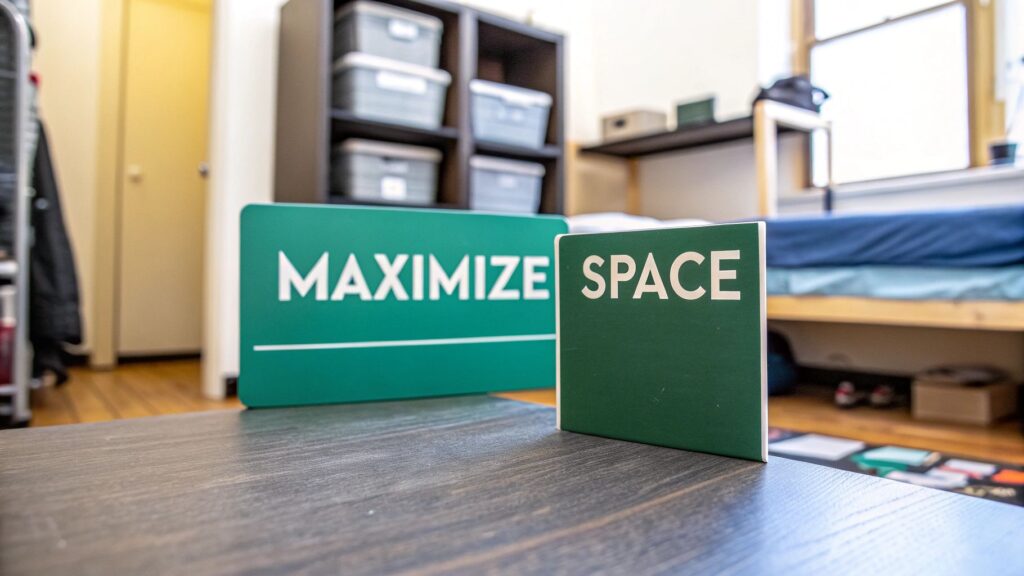Living in a small apartment offers charm and convenience, but keeping it organized can feel like a constant battle against clutter. Every square foot is precious, making smart storage not just a luxury, but a necessity for maintaining a functional and peaceful home. This is especially true for students and young professionals in vibrant areas like South Florida, who need their space to seamlessly transition between studying, working, and relaxing.
This guide moves beyond generic advice to provide eight innovative and practical small apartment organization ideas that will transform how you use your space. We'll explore actionable strategies to maximize vertical real estate, leverage multi-functional furniture, and implement intuitive systems that keep your apartment feeling open, airy, and effortlessly cohesive. You will learn how to reclaim unused areas and create designated zones for every activity, turning limited square footage into a major asset.
These techniques are designed for immediate implementation, whether you're in a cozy one-bedroom or a compact studio. To gain an even broader perspective on maximizing your compact living area, you can also delve into other clever small space storage ideas. Our focus here is on creating a serene and highly functional environment, proving that you don't need a large home to live a well-organized life.
1. Go Vertical: The Untapped Potential of Your Walls
When floor space is at a premium, the most effective strategy is to look up. Vertical storage is a cornerstone of small apartment organization ideas because it transforms your walls from mere partitions into high-capacity storage assets. This approach involves using tall bookcases, floating shelves, and wall-mounted systems to draw the eye upward, creating a sense of height and space while keeping your floors clear and walkable. It’s about maximizing the often-neglected vertical dimension of your apartment to store everything from books to kitchen supplies without sacrificing a single square foot of living area.
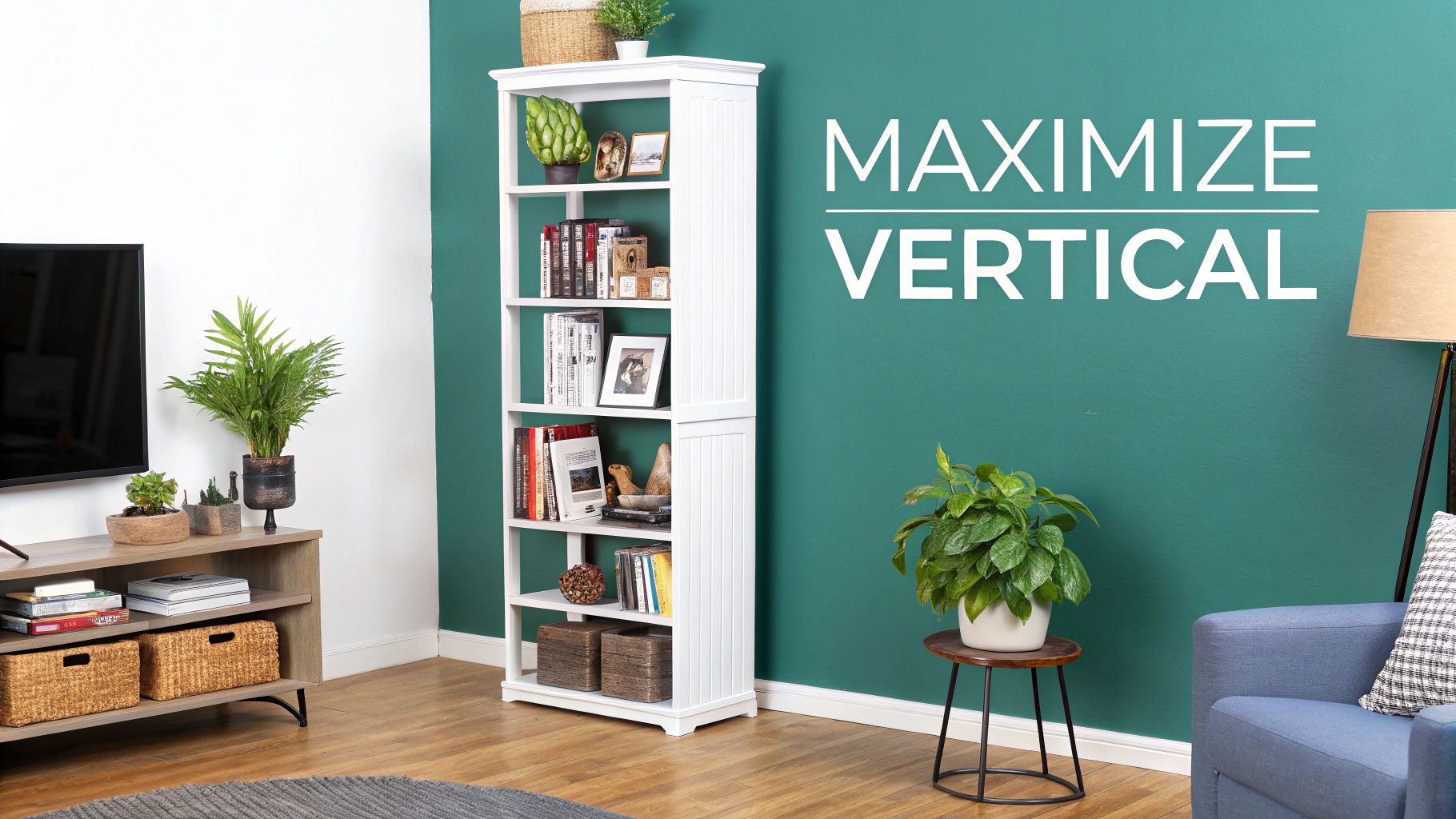
This method is particularly effective for students at FAU or young professionals in South Florida, where studio and one-bedroom apartments are common. Instead of a bulky, wide dresser, a tall, narrow shelving unit offers the same storage volume while occupying minimal floor space. It’s not just about adding shelves; it's a strategic shift in how you view your apartment’s storage potential.
How to Implement Vertical Storage
Getting started with vertical storage is straightforward. Focus on key areas where clutter accumulates, such as the living room, kitchen, or home office nook.
- Living Area: Install floating shelves above your television to display photos, plants, and books. A floor-to-ceiling shelving system, like IKEA’s popular IVAR unit, can serve as both a statement piece and a powerful storage hub.
- Kitchen: Use a wall-mounted pot rack to free up cabinet space. Install narrow spice racks on the inside of pantry doors or on an empty sliver of wall. A custom pegboard wall can hold everything from utensils to pans, offering flexible and accessible storage.
- Above Doorways: The space above a doorway is often completely unused. A single, sturdy shelf installed here is perfect for storing items you don't need daily, such as seasonal decorations, extra linens, or travel bags.
Pro Tip: For maximum safety and stability, always anchor tall or heavy shelving units directly to wall studs, especially when storing heavy items like textbooks or kitchen appliances. Using a stud finder is a non-negotiable step in this process.
2. Embrace Multi-Functional Furniture: The Art of Doing More with Less
In a compact living space, every piece of furniture must justify its footprint. This is where multi-functional furniture becomes one of the most powerful small apartment organization ideas. The strategy is simple: choose pieces that serve two, or even three, distinct purposes. This approach combines sleeping, storage, seating, and work surfaces into single, elegant items, drastically reducing clutter and maximizing the utility of every square inch. Instead of needing a separate bed, sofa, and storage chest, a single daybed with built-in drawers can fulfill all three roles.
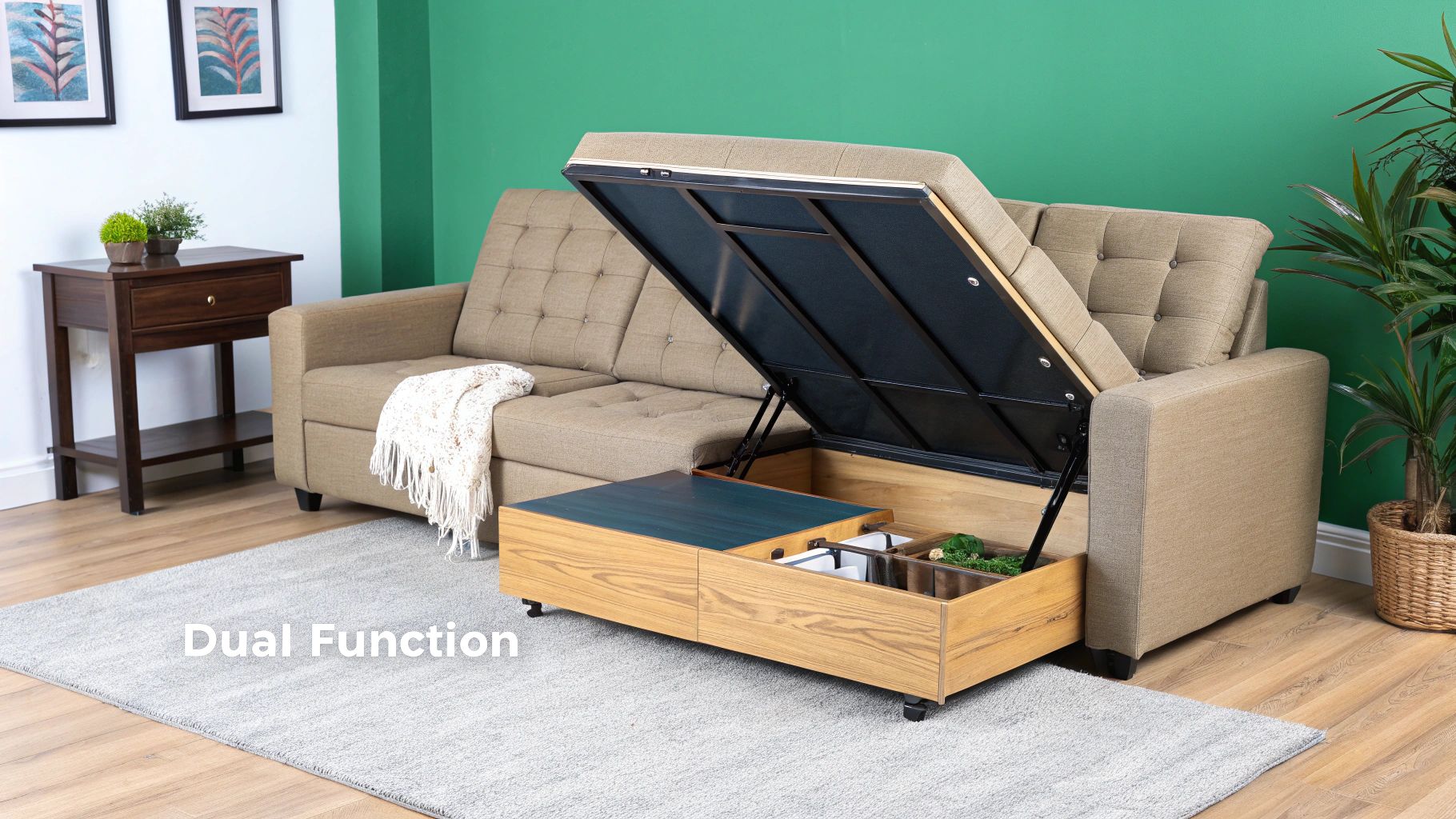
This method is a game-changer for anyone in a studio or one-bedroom apartment, where a bulky bed or a sprawling dining table can consume the entire living area. A coffee table that lifts to become a dining or work surface, or an ottoman that opens to reveal storage for blankets and board games, frees up valuable floor space. This isn't just about saving space; it's about creating a dynamic, adaptable environment that can transform to meet your needs throughout the day.
How to Implement Multi-Functional Furniture
Integrating these smart pieces into your apartment is about identifying your biggest space-consumers and finding a dual-purpose replacement.
- Living and Sleeping Areas: A sofa bed or a daybed like IKEA’s HEMNES model instantly provides guest sleeping arrangements without requiring a dedicated guest room. For the ultimate space-saver, a Murphy bed can fold away into the wall, often revealing a built-in desk or shelves for daytime use, a concept perfected by companies like Ori Systems.
- Dining and Working: An expandable dining table can remain small for daily use and extend to accommodate guests. A console table behind your sofa can double as a narrow desk, which is a great way to create a dedicated work-from-home setup without a separate office.
- Storage and Seating: A storage ottoman is a classic choice. It serves as a coffee table, extra seating for guests, and a hidden compartment for everything from magazines to remote controls. A storage bench in an entryway provides a place to sit and put on shoes while neatly hiding them away.
Pro Tip: Before purchasing a large convertible piece, measure your doorways, hallways, and stairwells. It’s crucial to ensure you can actually get the furniture into your apartment. Also, test any conversion mechanisms in the store to ensure they are smooth and durable for long-term use.
3. Under-Bed Storage Systems
The space beneath your bed is one of the most underutilized real estate goldmines in a small apartment. Under-bed storage systems transform this dead zone into a highly efficient, concealed organizational area. This is a foundational element of small apartment organization ideas because it offers a significant amount of storage without adding any visual clutter to your living space. The concept involves using specialized bins, drawers, vacuum bags, or even bed frames with built-in storage to house items you don't need every day, keeping your room tidy and serene.
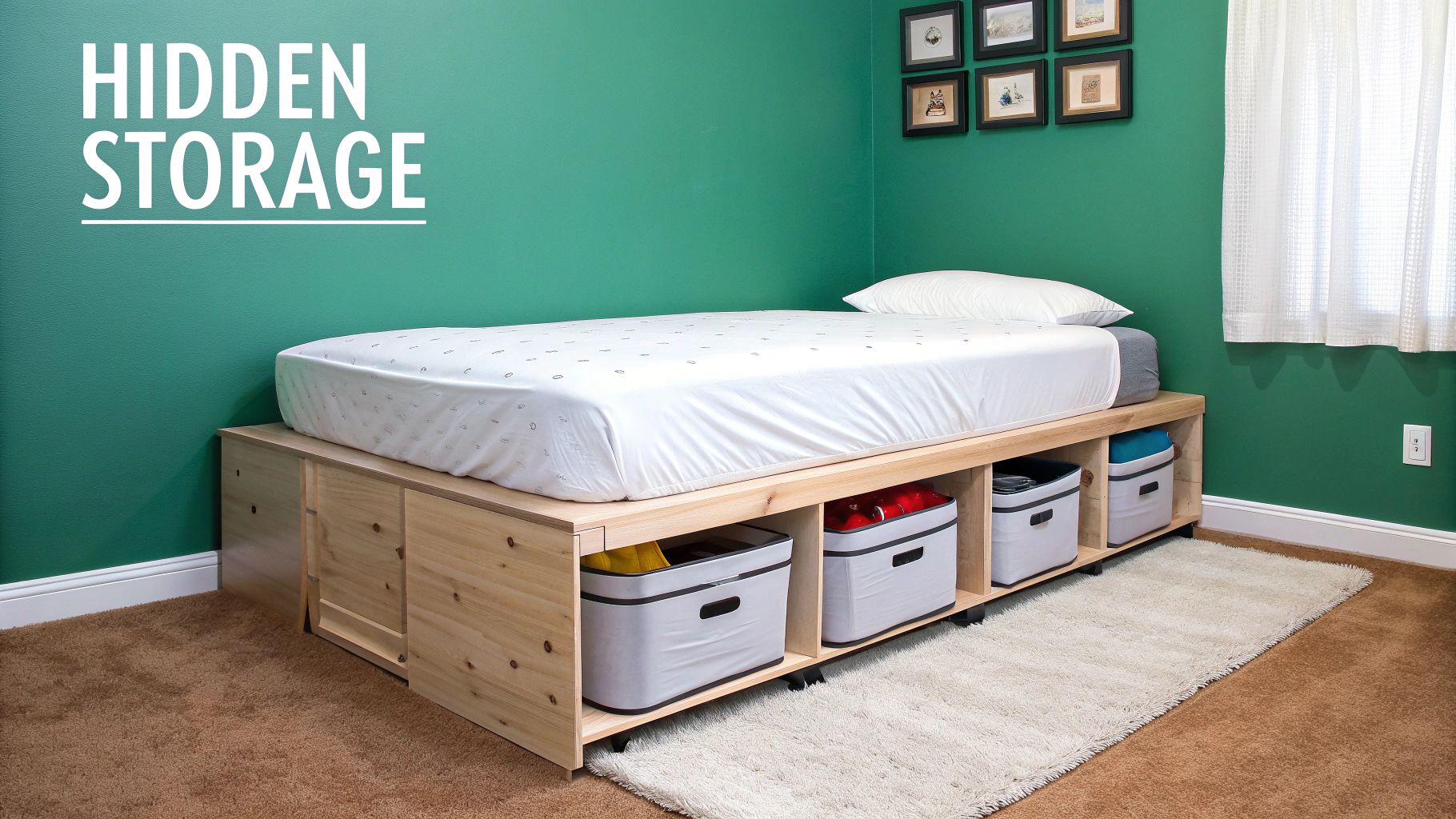
This strategy is particularly beneficial for students at FAU or young professionals in Boca Raton, where closet space can be limited. Instead of cramming seasonal wardrobes or bulky extra bedding into a packed closet, you can neatly tuck them away, freeing up prime storage real estate for your daily essentials. It’s a simple yet powerful way to expand your storage capacity without sacrificing precious floor space.
How to Implement Under-Bed Storage
Maximizing your under-bed space is simple with the right tools and a bit of planning. The key is to select solutions that fit your bed's clearance and your specific storage needs.
- Containers & Bins: Use low-profile, wheeled containers like Sterilite rolling carts for items you need to access more often, such as shoes or gym clothes. For long-term storage, IKEA’s SKUBB boxes are perfect for keeping linens and winter sweaters organized and dust-free.
- Vacuum-Sealed Bags: To store bulky items like comforters, pillows, and heavy coats, Ziploc Space Bags are a game-changer. They compress items down to a fraction of their original size, allowing you to fit far more under your bed.
- Bed Risers: If your bed frame is too low, a set of sturdy bed risers can instantly create 6-8 inches of valuable new storage height. This inexpensive solution dramatically increases the volume of what you can store underneath.
Pro Tip: Always measure the clearance from the floor to your bed frame before buying any containers. For easy access and organization, label every bin and group similar items together, such as "Winter Scarves & Hats" or "Extra Towels & Sheets."
4. Door and Over-Door Organization
One of the most overlooked surfaces in any apartment is the back of a door. Door and over-door organization turns these vertical planes into powerful storage assets without drilling a single hole. This approach uses hanging organizers, hooks, and racks that simply slip over the top of a door, instantly creating new real estate for shoes, accessories, pantry items, or cleaning supplies. It's one of the most effective small apartment organization ideas because it adds significant capacity to a room without occupying any floor space.
This method is a non-negotiable for renters, especially students in dorms or young professionals in South Florida apartments where permanent modifications are restricted. Instead of letting clutter pile up in a closet or bathroom, an over-door organizer provides a designated home for dozens of items. Brands like SimpleHouseware and Command have made this strategy accessible and damage-free, solidifying its place as a small-space living essential.
How to Implement Door Organization
Leveraging your doors for storage is simple and can be applied throughout your apartment, from the front door to the bathroom.
- Bedroom and Closet: Use a classic clear-pocket shoe organizer on your closet door. Repurpose it to hold scarves, belts, rolled-up t-shirts, or small accessories. A hanging jewelry organizer from a brand like Misslo can keep necklaces untangled and easy to see.
- Kitchen and Pantry: A wire rack system, like the Whitmor over-the-door pantry organizer, is perfect for holding spices, jars, and canned goods. This frees up precious cabinet and counter space, which is critical in a compact Boca Raton kitchen.
- Bathroom and Laundry: The back of the bathroom door is the ideal spot for a rack that holds towels or a caddy for toiletries and cleaning supplies. This keeps your vanity clear and products within easy reach.
Pro Tip: Before buying an over-door unit, measure the thickness of your door and the clearance above it. Place small felt pads on the back of the metal hooks to prevent any scuffing or rattling, ensuring your door stays in perfect condition.
5. Zone-Based Organization System
Instead of organizing your apartment room by room, a zone-based system groups items by function and activity. This is one of the most transformative small apartment organization ideas because it creates logical, intuitive homes for everything you own, based on how you actually live. By dividing your space into functional zones for specific activities like cooking, working, or relaxing, you ensure that related items are stored together, right where you need them. This method streamlines your daily routines and prevents clutter from migrating across your home.
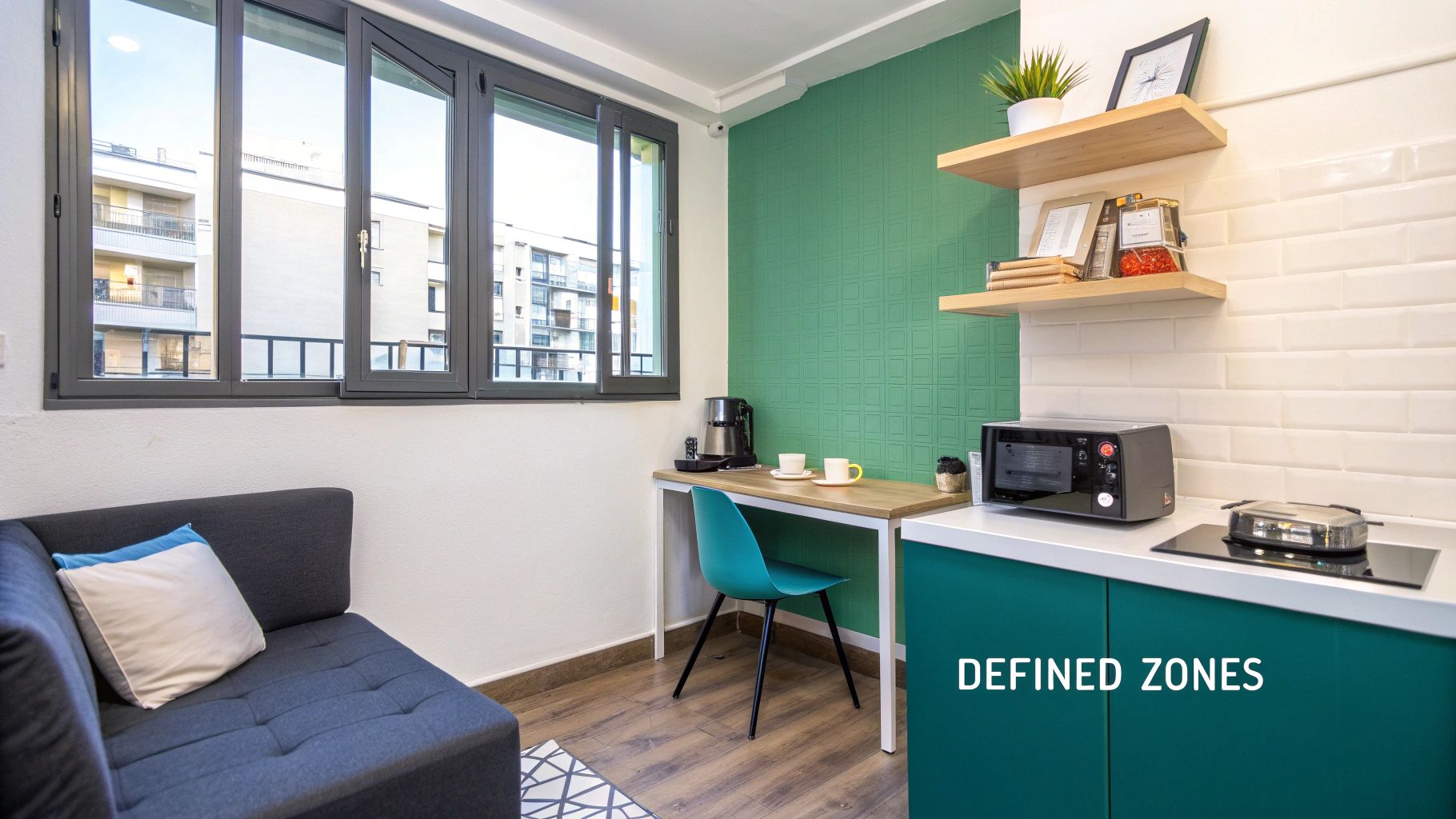
For those in compact living situations, such as a 300 sq ft studio in Boston or a student apartment near FAU, zones may overlap, but the principle holds. A small corner can become a dedicated coffee station, or the area by the door can be an "entryway drop zone" for keys and mail. This approach, popularized by organization experts like Marie Kondo and The Home Edit, makes maintaining order feel natural rather than like a constant chore.
How to Implement a Zone-Based System
Start by mapping your daily routines to identify the essential zones you need. To effectively plan your space and ensure purposeful placement in your small apartment, consider using tools like an interior design bubble diagram to simplify layout planning.
- Create a "Landing Zone": Designate a small area near your front door for daily-carry items. Use a small tray for keys and mail, a hook for your bag, and a shoe mat. This prevents entryway clutter from spreading into your living space.
- Establish a Work Zone: Even without a separate office, you can create a work zone. Keep your laptop, chargers, notebooks, and pens together in a portable caddy or on a designated shelf near where you typically work.
- Define Kitchen Zones: Group items by task. Create a prep zone with cutting boards and knives near the sink. Establish a cooking zone with pots, pans, and utensils near the stove. A coffee or tea zone can consolidate mugs, your coffee maker, and supplies in one convenient corner.
- Design a Morning Routine Zone: In your bathroom, group all your morning essentials like your toothbrush, skincare, and makeup in one designated drawer or cabinet section to make getting ready faster and more efficient.
Pro Tip: Use drawer dividers, small bins, and trays to create clear boundaries within larger storage areas. These tools are essential for maintaining the integrity of each zone, preventing items from getting mixed up, and keeping your system organized long-term.
6. Kitchen Cabinet and Pantry Optimization
The kitchen is the heart of the home, but in a small apartment, it can quickly become a source of clutter and chaos. Kitchen cabinet and pantry optimization is a crucial strategy among small apartment organization ideas, focusing on transforming cramped, disorganized storage into a highly efficient and functional system. This approach uses specialized organizers like tiered shelving, pull-out drawers, and door-mounted racks to maximize every square inch, ensuring no space is wasted. By making everything visible and accessible, you create a smoother cooking experience and reduce food waste.
For a busy FAU student or a young professional in Boca Raton, a well-organized kitchen saves precious time and money. Instead of rummaging through a deep pantry, imagine seeing all your pasta, grains, and spices at a single glance. This system isn’t about buying more storage; it's about making your existing storage work smarter, a philosophy championed by organization experts like The Home Edit. To dive deeper into specific products and layouts, you can find a wealth of information about Kitchen Cabinet and Pantry Optimization.
How to Implement Kitchen Optimization
Start by emptying one cabinet or pantry shelf at a time. Assess what you have, discard expired items, and then rebuild with a system in mind.
- Decant and Contain: Transfer dry goods like flour, sugar, and snacks into clear, stackable, airtight containers. Brands like OXO offer systems that are both functional and aesthetically pleasing. Label everything clearly.
- Create Tiers: Use tiered shelf risers for canned goods, spices, and jars. This allows you to see everything in the cabinet without having to move items in the front, solving the "lost in the back" problem.
- Utilize Doors and Corners: Install racks on the inside of cabinet doors to hold spices, foil, or cleaning supplies. Place a lazy Susan (turntable) in a deep corner cabinet to bring oils, vinegars, and condiments to the front with a simple spin.
- Divide and Conquer: Use drawer dividers for utensils, cutlery, and small gadgets. For deep cabinets, install pull-out drawers or bins to easily access pots, pans, and small appliances without having to dig.
Pro Tip: Before you buy any organizers, measure your cabinets carefully. Account for height, width, depth, and any obstructions like pipes or shelf lips to ensure your new tools fit perfectly and maximize the space.
7. Closet Maximization Systems
A standard apartment closet, with its single rod and high shelf, is a notorious black hole for storage potential. Closet maximization systems are one of the most transformative small apartment organization ideas because they strategically overhaul this underutilized space. This approach involves installing modular shelving, additional hanging rods, and specialized organizers to create a highly efficient, multi-layered storage hub. Instead of a chaotic pile, your closet becomes a well-ordered system that can often double or even triple its holding capacity, making it a critical upgrade for any small living space.
This strategy is a game-changer for budget-conscious renters and young professionals in Boca Raton, where every square inch counts. Systems like IKEA's PAX or Elfa from The Container Store allow you to design a custom-fit solution without a full renovation. It's about fundamentally rethinking the closet from a simple box to a dynamic storage engine, tailored specifically to your wardrobe and accessories.
How to Implement Closet Maximization
Before you buy anything, the first step is to completely empty your closet, declutter, and take precise measurements. Once you have a clean slate, you can build a system that works for you.
- Double Your Hanging Space: The easiest and most impactful change is adding a second hanging rod. Install one at standard height and another around 40 inches below it for shirts, skirts, and folded pants, instantly doubling your capacity.
- Utilize Uniform Hangers: Switch to slim, non-slip velvet hangers, like the famous Huggable Hangers. Their thin profile allows you to fit significantly more clothing onto the rod compared to bulky plastic or wooden ones.
- Add Vertical Shelving: Install a narrow shelving tower on one side of the closet for folded items like sweaters and jeans. Use shelf dividers to keep stacks neat and prevent them from toppling over.
- Leverage the Door: An over-the-door organizer with clear pockets is perfect for storing shoes, scarves, belts, and other small accessories, freeing up valuable shelf and floor space. To learn more, explore these closet maximization tips on cynthiagardens.com.
Pro Tip: Keep a designated donation bag inside your closet. As you come across items you no longer wear, toss them in immediately. This turns decluttering from a major project into a simple, ongoing habit.
8. Embrace Flexibility with Modular and Stackable Storage
Modular storage is the ultimate chameleon of small apartment organization ideas, offering unmatched flexibility for evolving needs. This approach uses standardized, interchangeable units like cubes, bins, and drawers that can be stacked, connected, and reconfigured in countless ways. Unlike traditional, fixed furniture, a modular system can grow, shrink, or change its function entirely, making it perfect for the dynamic lifestyle of a student or young professional. It adapts to you, not the other way around.
This adaptability is invaluable for renters in Boca Raton who may move apartments or need a single space to serve multiple functions. A cube system that acts as a TV stand in a first apartment can be reconfigured into a closet organizer or even a room divider in a larger studio down the line. It's a sustainable, long-term investment that prevents you from having to buy new furniture every time your living situation changes.
How to Implement Modular Storage
Getting started with modular systems means thinking about both your current and future needs. Focus on areas that require adaptable storage solutions.
- Create Zones in a Studio: Use a tall cube unit, like IKEA’s KALLAX, to visually separate your sleeping and living areas. Fill some cubes with decorative bins for hidden storage and leave others open for books or plants to maintain an airy feel.
- Maximize Closet Space: Build a custom closet interior using stackable drawer units from brands like Sterilite or Elfa. This creates designated spaces for folded clothes, accessories, and shoes, turning a cluttered closet into a functional wardrobe.
- Build a Custom Pantry: In kitchens with limited cabinet space, stackable wire or plastic bins can create a freestanding pantry. Label each bin clearly (e.g., "Snacks," "Grains," "Baking") for quick and easy access to your supplies.
Pro Tip: When stacking modular units, always prioritize safety. For any system stacked higher than your waist, use the included wall anchors to secure it firmly. This prevents tipping, especially in households with pets or active foot traffic.
Small Apartment Organization Ideas Comparison
| Storage Solution | Implementation Complexity 🔄 | Resource Requirements ⚡ | Expected Outcomes 📊 | Ideal Use Cases 💡 | Key Advantages ⭐ |
|---|---|---|---|---|---|
| Vertical Storage Solutions | Beginner to Intermediate (requires tools, installation) 🔄🔄 | Moderate ($50-$500) ⚡ | Maximizes storage without floor space; visual uplift 📊 | Small apartments, non-permanent spaces | Cost-effective; customizable; easy reconfiguration ⭐ |
| Multi-Functional Furniture | Easy to use; installation may need professionals 🔄 | High ($200-$5,000) ⚡ | Reduces furniture footprint; flexible space use 📊 | Studios, one-bedrooms <600 sq ft | Dual/triple use; hidden storage; flexible living ⭐ |
| Under-Bed Storage Systems | Beginner-friendly 🔄 | Low to Moderate ($20-$300) ⚡ | Utilizes wasted space; hidden, dust-free storage 📊 | Seasonal items; extra linens; shoes | Cost-effective; accessible; maintains clean look ⭐ |
| Door and Over-Door Organization | Beginner; no tools needed 🔄 | Low ($10-$80 per door) ⚡ | Adds storage on unused door space; renter-friendly 📊 | Shoes, accessories, cleaning supplies | No damage; inexpensive; versatile and easy install ⭐ |
| Zone-Based Organization System | Intermediate; requires planning & upkeep 🔄🔄 | Moderate ($50-$300) ⚡ | Creates intuitive, maintainable storage; reduces clutter 📊 | People prone to clutter returning | Improves routines; simplifies cleaning; space planning ⭐ |
| Kitchen Cabinet and Pantry Optimization | Beginner to Intermediate; installation/time needed 🔄🔄 | Moderate ($100-$500) ⚡ | Increases cabinet space & accessibility; reduces waste 📊 | Frequent cooks; limited kitchen storage | Functional workflow; tidy & visually appealing ⭐ |
| Closet Maximization Systems | Intermediate DIY; easy if professional help 🔄🔄 | Moderate to High ($100-$2,000) ⚡ | Triples closet capacity; improves wardrobe visibility 📊 | Overflowing closets; small closets | Customizable; renter-friendly options; protects clothes ⭐ |
| Modular and Stackable Storage Systems | Beginner; minimal assembly 🔄 | Low to Moderate ($30-$500) ⚡ | Flexible, adaptable storage; easy to expand or move 📊 | Renters; students; changing spaces | Portable; expandable; versatile for any room ⭐ |
Creating Your Organized Oasis
Transforming your compact living area from a source of clutter-induced stress into a serene and functional sanctuary is not just a dream; it's an achievable goal. Throughout this guide, we've explored a wealth of small apartment organization ideas designed to unlock the hidden potential within your home. By embracing these strategies, you empower yourself to create a space that feels significantly larger, more intuitive, and perfectly aligned with your South Florida lifestyle.
The journey to an organized home is built on a foundation of smart, strategic choices. It begins with shifting your perspective-seeing blank walls not as limits, but as opportunities for vertical storage, and recognizing the untapped potential beneath your bed or behind your doors. It’s about making your furniture work harder for you, investing in multi-functional pieces that serve dual purposes without demanding extra square footage.
Key Takeaways for a Clutter-Free Life
The most effective organizational systems are not about restriction; they are about liberation. By implementing the concepts we've discussed, you can free up both physical space and mental energy.
- Think Vertically: Drawing the eye upward with tall shelving and wall-mounted units creates an illusion of spaciousness while maximizing storage capacity.
- Embrace Multi-Functionality: From ottoman beds to convertible coffee tables, choosing furniture that serves multiple roles is the ultimate space-saving hack for young professionals and students.
- Create Intentional Zones: Designating specific areas for work, relaxation, and dining brings order and purpose to an open-plan layout, preventing functional overlap and clutter.
- Maximize Hidden Spaces: The areas under your bed, over your doors, and inside your cabinets are prime real estate. Utilizing custom dividers, tiered shelves, and specialized organizers can double their utility.
Your Action Plan for Lasting Organization
The secret to maintaining an organized apartment is to integrate these systems into your daily life, making tidiness a natural habit rather than a monumental task. The best approach is to start small. Don't attempt to overhaul your entire apartment in one weekend. Instead, choose one area to focus on first, perhaps the one that causes you the most frustration, like a cramped closet or a chaotic kitchen pantry.
Implement one or two of the strategies we've outlined. Install a closet maximization system or dedicate an afternoon to optimizing your kitchen cabinets with drawer dividers and pull-out shelves. Once you experience the immediate benefits of that single improvement, you will feel motivated to continue. Remember, the goal is to create a sustainable system that works for you. An organized home supports a clearer mind, boosts productivity, and provides a peaceful retreat from the outside world-a personal oasis where you can truly relax and recharge. These small apartment organization ideas are your blueprint for building that reality.
Ready to apply these organization strategies in a space designed for modern living? The thoughtfully laid-out one and two-bedroom floor plans at Cynthia Gardens provide the perfect canvas for your organizational creativity. Discover your new Boca Raton home and start building your beautifully organized life by visiting Cynthia Gardens today.
